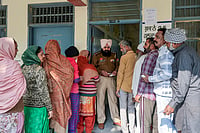The Supreme court is hearing petitions challenging the validity of Section 6A of the 1955 Citizenship Act which relates to illegal immigrants in Assam. The five-judge constitutional bench headed by Chief Justice DY Chandrachud commenced its hearing on Tuesday.
The CJI said the court was deliberating on the impact of the provision, between 1966 and 1971, and whether it brought about a big change in the cultural identity of Assam.
Senior Advocate Shyam Divan, representing the petitioners, argued that this provision has resulted in a demographic influx, infringing upon the cultural rights of the people in Assam.
What is Section 6A of the Citizenship Act 1955?
Section 6A was inserted into the 1955 Citizenship Act in 1985. It is a special provision on citizenships of persons covered by the Assam Accord.
This provision says that if people arrived in Assam between January 1, 1966, and March 25, 1971, from certain places like Bangladesh, and have been living in Assam since then, they are eligible for Indian citizenship.
The provision, hence established March 25, 1971 as the cut-off date for granting citizenship to migrants from Bangladesh in Assam.
Before the introduction of Section 6A, the Assam Accord provided citizenship and the right to vote only to those immigrants who came to Assam before 1 January 1966. Immigrants who entered Assam after 1 January 1966 but before 24 March 1971 would be considered Indian citizens but would not be allowed to vote for the first 10 years following their detection as Indian citizens. Immigrants who entered Assam on or after 25 March 1971 would be considered illegal immigrants and would be expelled from India.
What is the Assam Accord?
The Assam Accord of 1985 was a tripartite agreement signed by the Union of India, the All Assam Students’ Union (AASU) and the All Assam Gana Sangram Parishad.
The Accord's signing ended a six-year agitation by AASU in 1979 demanding the identification and deportation of illegal immigrants who started coming to Assam following the 1971 Bangladesh Liberation War.
The influx of foreign nationals into Assam raised concerns about potential adverse effects on the state's demography. Prime Minister Indira Gandhi initiated discussions with the AASU and All Assam Gana Sangram Parishad in 1980, which then continued under Prime Minister Rajiv Gandhi in 1985. The Accord, signed later in 1985, addressed various aspects of the issue, including constitutional, legal, international, national, and humanitarian considerations.
The most important clause of the Assam Accord was the Foreigners Issue (clause 5). It set the rules for citizenship and divided the immigrants into three sections based on when they came to Assam. As mentioned above, those who came to Assam before 1 January 1966 would be considered Indian citizens and be allowed to vote. Those who entered Assam after 1 January 1966 but before 24 March 1971 would be considered Indian citizens but would not be allowed to vote for the first 10 years following their detection as Indian citizens. Immigrants who entered Assam on or after 25 March 1971 would be considered illegal immigrants and would be asked to return.
Supreme Court proceedings
The Supreme Court led by Chief Justice DY Chandrachud highlighted the humanitarian basis of Section 6A of the Citizenship Act, rooted in India's historical role in the liberation of Bangladesh.
The court observed that if Parliament were to simply provide amnesty to a specific group of illegal immigrants, that would be a different situation.
The Supreme Court on Thursday sought data from the Union Government on immigrants granted Indian citizenship under this section and the steps taken by the government to curb illegal immigration into the territory of India, particularly the North-Eastern States
In the course of the proceedings, the Chief Justice inquired why ‘Assam was singled out' in the application of Section 6A of the Citizenship Act, especially considering that West Bengal shares a larger border with Bangladesh.


























